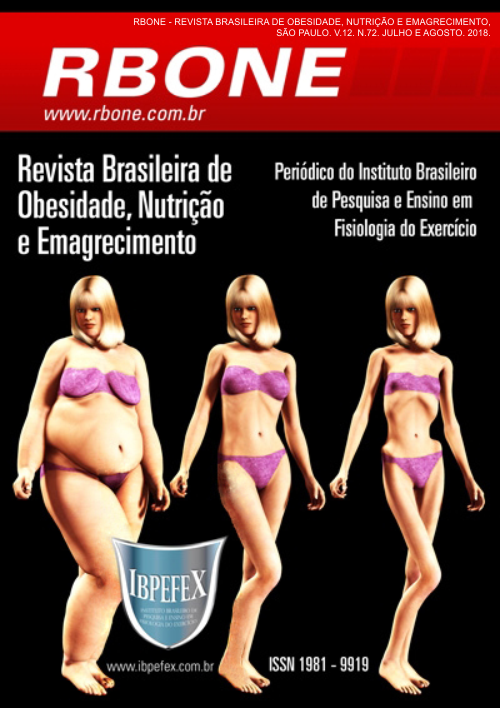Food behavior between men and women with eating disorders
Abstract
Eating disorders, are characterized by a persistent eating disorder or behavior related to it. The objective of this research was to compare the eating behavior between men and women with eating disorders. The records of all patients in the Group of Assistance in Eating Disorders at Hospital das Clínicas de Ribeirão Preto-USP from its foundation 1982 to May 2017, with a total of 243 patients. Included male patients independent of age, diagnosed with AN and BN. Excluding pregnant women, incomplete records and patients with different diagnoses, resulting in 12 men and 20 women. Data regarding sex, BMI, treatment time, disease evolution and eating behavior were collected, the 24 hour recall using Diet Pro 5i. No difference was found between the ages of the male and female groups (p = 0.1118), initial BMI (p = 0.068) and final (p = 0.4817). In the male group, the final BMI was higher than the initial BMI (p = 0.0096). A similar result was found in the female group (p = 0.0001). The proportion of subjects reporting vomiting was higher in the male group (p = 0.0373), laxative / diuretic (p = 0.0217), diet / light (p = 0, 0400) meals on the sly (p = 0.0386). There was no difference between the groups regarding the use of sweetener (p = 0.2233), main and nocturnal meals (p = 0.1478)/(p = 0.1429) and avoidance fatty foods (p = 0.4432). It was concluded that the men had inadequate dietary behaviors superior to those of women. It is suggested that more research be done to better understand these pathologies in order to improve care and prognosis.
References
-Alvarenga, M; Scagliusi, F.B; Philippi, S.T. Nutrição e transtornos alimentares. Barueri. São Paulo. Manole. 2011.
-American Psychiatric Association (APA). Diagnostic and Statiscal Manual of Mental Disorders. 5th ed. Arlington. American Psychiatric Association. 2013.
-Andrade, T.F. O imaginário da perfeição: a corporeidade em homens com transtorno alimentar. Ribeirão Preto. 2008.
-Araújo, A; Melina, P. Transtornos alimentares em homens: um desafio diagnostico. Revista Brasileira de Psiquiatria. Vol. 24. Num. 3. 2014. p. 73-76.
-Brownell, K.D; Hotelling, K.J; Lowe, M.R; Rayfield, G.E; American Psychiatric Assosciation. 2011.
-D`Agostino e Pearson. Real Statistics Using Excel: 2013-2017.
-Fortes, L.S., Almeida, S.S., Cipirani, F.M.; Ferreira, E.C. Inappropriate eating behavior: a longitudinal study with female adolescents. Revista Paulista de Pediatria. Vol. 32 Num. 2014. p. 85-91.
-Morgan, C.M.; Vecchiatti, I.R.; Negrão, A. B. Etiologia dos transtornos alimentares: aspectos biológicos, psicológicos e sócio-culturais. Revista Brasileira de Psiquiatria. Vol. 24. 2002. p. 18-23.
-Moraes, R. W. Determinantes e construção do comportamento alimentar: uma revisão narrativa da literatura. Porto Alegre. 2014.
-Pina, M. G. M. Transtornos alimentares: modelo e consenso cultural na alimentação. Tese de Doutorado. USP. Ribeirão Preto. 2014.
-Scagliusi, F.B.; Ferriolli, E.; Prfrimer, K. Characteristics of women who frequentlyunderreport their energy intake: a doubly labelled water study. Eur J ClinNutr. Vol. 63. Núm. 1. p. 1192-1199. 2009.
Authors who publish in this journal agree to the following terms:
- Authors retain the copyright and grant the journal the right of first publication, with work simultaneously licensed under the Creative Commons Attribution License BY-NC which allows the sharing of the work with acknowledgment of the authorship of the work and initial publication in this journal.
- Authors are authorized to enter into additional contracts separately for non-exclusive distribution of the version of the work published in this journal (eg, publishing in institutional repository or book chapter), with acknowledgment of authorship and initial publication in this journal.
- Authors are allowed and encouraged to post and distribute their work online (eg, in institutional repositories or on their personal page) at any point before or during the editorial process, as this can bring about productive change as well as increase impact and impact. citation of published work (See The Effect of Free Access).






